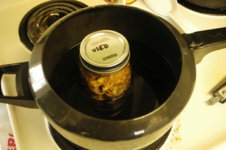Pressure Cooker Cavendish in Jars
In the past, I've made Cavendish by steaming the loose leaf in a collander, inside a pot of water (~8 hours), and in a different batch by pressure-cooking it as loose leaf suspended within a pressure cooker (~5 hours).
The current method uses 1 quart, wide-mouth mason jars with proper seals (like you would use for canning green beans). The leaf was misted to high case, stuffed haphazardly into a jar, then sealed with the cap and rim. I made up 4 jars, each with a different variety of leaf: Colombian Garcia, BigBonner Burley Red Tips, Guácharo, and Harrow Velvet burley. The Colombian Garcia was with stemmed leaf. The remaining 3 were stuffed into the jars stem and all. In fact, the last two in that list were misted as tied hands (the way I had stored them), then the complete hand was squished and jammed into its respective jar, still tied and tagged.

The jars were placed onto the standard, small, metal stand-off plate at the bottom of a large canning pressure cooker (which I believe will hold 9 1-quart jars). I added as much water to the cooker as I could, without causing the jars to float. The pressure cooker was brought up to pressure and temp (~15 psi), then the heat was set to allow a continuous, gentle rocking of the weight. Cooking continued for 5 hours, without interruption. It was allowed to cool naturally. Water still remained in the bottom of the cooker, once the batch was done, and the lid removed. (By placing my ear near the pot, I could hear the water bubbling, as it rattled the jars. BUT, I did check to see that all was well about every 10 minutes during the final couple of hours.)
The hot jars were lifted out of the canner using a pair of canning tongs, and placed on a wood cutting board to cool. These jars are completely sealed and
sterilized inside. The tobacco in them should remain microbe free indefinitely, regardless of the moisture content.
The following day, I removed the soggy Colombian Garcia leaf, and arranged it to fit in 1/2 of a 1 quart Ziplock freezer bag. The bag was folded over, and left open. This was then placed beneath my lever-arm press--a cheese press, actually. Years ago, when I made this press, I measured the applied weight (using a scale) at the various notches on the lever arm, with a series of different weights suspended from the end of the lever (empty, 1 quart, 2 quarts, 4 quarts, the latter 3 being 2, 4 and 8 pounds respectively). The results of these measurements were printed-out, and pasted onto the end of the arm for future reference. For this particular batch, I used a glass mug suspended from the end of the arm.
The mug weighed 2 pounds. So the
weight applied to the tobacco in the bag was 9 pounds. The folded bag is roughly 4" x 7", or 28 in[sup]2[/sup]. This tells me that the applied
pressure was only ~ 0.32 psi. The tobacco was pressed for only 24 hours, since the goal was to make a cake that could be sliced, rather than a consolidated mass.
The color of this Colombian Garcia was a medium brown, when the cooking was done--similar in color to the tobacco in the other 3 jars. After this light pressing, it achieved the darker color that you see.
The cake was somewhat loose, and could have been taken apart fairly easily. Instead, I cut the cake into blocks 1 inch wide, using a Kuhn-Rikon kulu (6" blade).
These blocks were then sliced into flake.
The flake was spread onto a seedling heat mat that had been lined with a sheet of plastic wrap. It should take a day or three to dry.
The aroma rising from the flake is delicious and rich.
Bob
EDIT: I should add that using this method, the house was not filled with the smell of cooking tobacco. That may be a plus for some members.
EDIT 2: I just noticed that my first post in this thread was 5 years ago. I'm a slow learner.




















